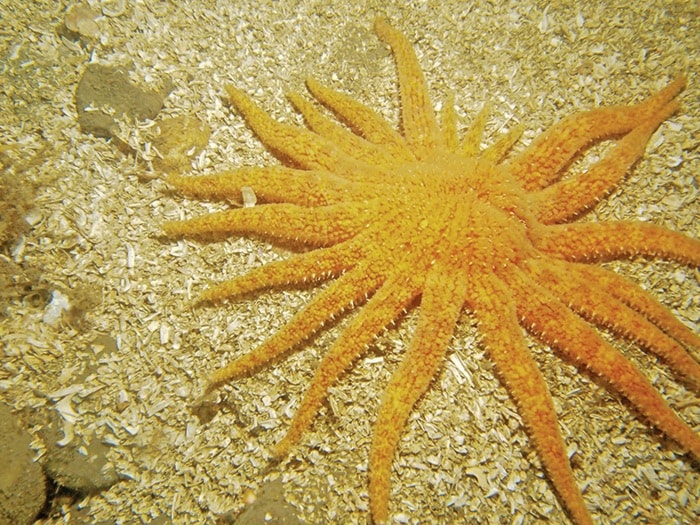The coast’s starfish are dying horrific deaths while scientists scramble to figure out why.
They’re also worried about how seastar wasting syndrome will affect ecosystems spanning Alaska to Cowichan to California.
“Since late August, we started noticing sunflower seastars dying off quite quickly,” said marine biologist Paula Romagosa, curator of Sidney’s Shaw Ocean Discovery Centre.
“The coastal diving community got involved doing survey dives. So far we don’t know why,” she said of the starfish die-off involving six or seven species.
“I’m quite scared, to be honest. We can’t figure out what it is, so there’s no way to control it — or know if it’ll affect our food sources like fish.”
Peter Luckham, a Thetis Island dive master who piloted Chemainus’ dive-reef jet, said he was stunned by the seastar decimation. He sends seastar data to the Vancouver Aquarium.
“It’s like science fiction. It decomposes into a pile of goo. If you could hear a scream under water, they’d be saying ‘I’m melting’, just like out of the Wizard Of Oz.”
Populations including sunflower, sun, basket, leather, pink, common purple, vermillion, and blood stars are dying, Luckham said.
“Brittle stars are the only ones I’ve noted not been affected.”
“We believe its some sort of virus,” said Romagosa, “but we haven’t been able to prove it yet.”
Proof of what’s wiping out about 30 per cent of the coast’s observable starfish could come from samples sent to Cornell University, explained Vancouver Aquarium’s Donna Gibbs.
Other samples have been sent to UBC, UVic, and California universities.
“It’s pretty shocking. We were surprised seeing seastars in dives during research around Howe Sound in some state of decay or meltdown.”
Divers started noticing melting and dissolving seastars in September in Howe Sound.
“It started with sunflower seastars, but has spread to other species,” said Romagosa. “California purple seastars are being affected more than other species.”
Gibbs said she’d never seen starfish deaths on this scale.
“Not on this magnitude. Before this, we saw an overabundance of these animals when they were just piled on top of each other on Hutt Island.”
Romagosa noted “it could be nature taking its course from overpopulation — or something we humans have done.”
Luckham was “quite alarmed” about the seastar’s demise between Nanaimo and Victoria.
“It appears to be some kind of pathogen, but I’m not a biologist. It completely wipes out the entire population.”
But the dive veteran hadn’t seen the disease’s wrath below 70 feet. “That indicates it’s also temperature sensitive, and not surviving in deeper water.
“What worries me is stars are a big predator; they eat everything they can find including other stars,” he said of the critter keeping others in balance.
He and Romagosa doubted the starfish crisis was sparked by Pacific radiation from the meltdown of Japan’s Fukushima nuclear plant.
“It’s hard to believe it’s radiation affecting the Vancouver area before the closest proximity to Japan. It could be an environmental reaction to overpopulation; it could be sewage, or pollution. Some species disintegrate in a couple of days; others will last longer.”
Dan Jacques, a diver and dock master at Maple Bay Yacht Club, was also shocked seeing seastar carnage in areas around the island, one of the Earth’s biggest seastar populations.
“There’s no way you can tell me this is natural. It’s a big wake-up call,” he said. “It’s just crazy.”
Crazy enough the legs are dropping off seastars he’s photographed “and they’re just rotting.”
Romagosa said the wasting-syndrome deaths look more like a viral infection — perhaps resembling the human ebola virus — affecting adult seastars.
“Some get bald spots, and get really skinny, and start to disintegrate. With others, their guts start coming through the pores in their skin. It’s a horrible sight to see; it’s terrifying. Their legs fall off and start walking away from the body.”
It’s tough to tell if seastars are in pain, she explained.
“They don’t have a brain, but do have a nervous system so they do have pain receptors, but we’ve seen no signs of distress from the ones in the aquarium. They go about their normal activities until they just fall apart.”
Romagoa’s other worry is about vital starfish roles in the food chain.
“Most seastars are top predators so this will affect everything in the food chain below them. All populations that depend on the seastars as a control system will start going unchecked.”
“The biggest thing,” said Gibbs, “is getting photographic evidence to us.”
Pictures can be sent to marketing@oceandiscovery.ca or aqua2@oceandiscovery.ca.
Also, visit www.vanaqua.org or aquablog to learn more.
